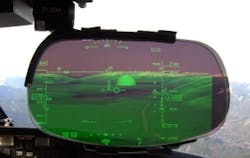Synthetic vision system on HUD from Rockwell Collins tested aboard Bombardier Global 5000 aircraft
Posted by John McHaleCEDAR RAPIDS, Iowa 13 May 2011. A series of flight tests designed to validate use of synthetic vision on a head-up display (HUD) were completed by Bombardier Aerospace and Rockwell Collins in Cedar Rapids, Iowa, and Bombardier Aerospace. The flight tests -- made on board a Bombardier Global 5000 test aircraft equipped with a Rockwell Collins Head-up Guidance System (HGS) -- were used to compare varying combinations of flight guidance symbology with and without synthetic vision on both the HUD and the head-down display (HDD) during ILS approaches.Preliminary results indicate that ILS tracking accuracy improved 70 percent laterally and 25 percent vertically when synthetic vision was displayed on the HUD. Tracking on the HDD with synthetic vision also showed improvement when compared to the HDD without synthetic vision.The tests were conducted to achieve operational credit for lower landing minima during Special Authorization (SA) CAT I ILS and WAAS LPV (Wide Area Augmentation System Localizer Performance with Vertical guidance) approaches."Our ultimate goal is to achieve operational credit for lower landing minima down to 100 feet, which will result in less rerouting of flights at hundreds of airports when visibility is low," says Greg Irmen, vice president and general manager, Business and Regional Systems for Rockwell Collins. "While more testing is needed, these initial findings support our philosophy that head-up, eyes-out is the preferred way to fly and the best approach for achieving our objective."In order to achieve lower landing minima for WAAS LPV approaches, the company plans to use its MultiScan weather radar to cross-check the vertical solution with respect to the runway. "It is not a matter of if technology will help pilots reach lower decision heights when landing, it's a matter of when," Irmen says.As a first step, Rockwell Collins and Bombardier Aerospace will be the first to certify synthetic vision on a HUD as part of its Pro Line Fusion avionics system on the Global Vision flight deck later this year. Initially, this will be for increased situational awareness only.Rockwell Collins co-chairs the Radio Technical Commission for Aeronautics (RTCA) Special Committee (SC)-213, which collaborates with the Federal Aviation Administration FAA to define the operational benefits of synthetic vision.
